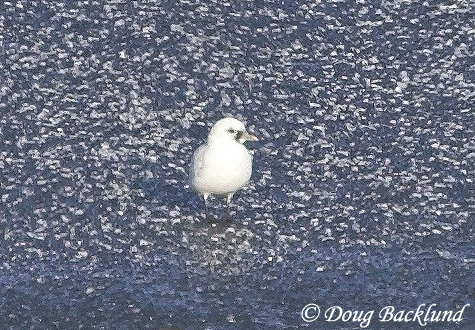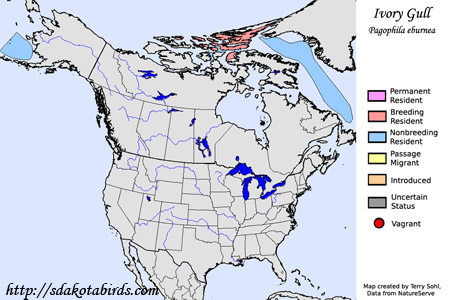Ivory Gull
Pagophila eburnea
| Length: 17 inches | Wingspan: 36 - 38 inches | Seasonality: Extremely rare Winter visitor |
| ID Keys: The only gull that is pure white (in adult plumage), with black legs and eyes, and an orange-tipped yellow bill. First-year birds may have a dark face and scattered black spots on their wings. | ||
 Ivory
Gulls are true birds of the Arctic, rarely being found away from the
vicinity of pack ice in the northern Arctic. They are the only gull
with a pure white plumage as adults, and even first-year birds only have a
smattering of darker markings on their face and wings. They do move
southward in the winter, following the edge of the expanding winter ice
pack, but only very rarely stray as far south as the Canada/United States
border. Ivory Gulls are unexpected in South Dakota were unknown here
until February 16th, 2008, when Ricky Olson spotted one at Oahe Dam near
Pierre.
Ivory
Gulls are true birds of the Arctic, rarely being found away from the
vicinity of pack ice in the northern Arctic. They are the only gull
with a pure white plumage as adults, and even first-year birds only have a
smattering of darker markings on their face and wings. They do move
southward in the winter, following the edge of the expanding winter ice
pack, but only very rarely stray as far south as the Canada/United States
border. Ivory Gulls are unexpected in South Dakota were unknown here
until February 16th, 2008, when Ricky Olson spotted one at Oahe Dam near
Pierre.
Habitat: Nearly always found in Arctic habitats, such as around floating pack ice, and near shorelines of extreme northern islands. Nests on rocky ground or rocky cliffs.
Diet: Varied, including a wide variety of marine life (small fish, crustaceans, mollusks, and insects). They are also willing scavengers, feeding on carcasses and even garbage dumps.
Behavior: Will feed in flight by dipping down to the water's surface and picking up small prey items. Also often feeds by simply walking along the ground or ice and foraging for small prey. Typically breeds in small colonies.
Breeding: Non-breeder in South Dakota
Song: Harsh mewing whistles, and other varied vocalizations.
Migration: Movements are typically limited to following the edges of pack ice, as they will move south as the Arctic ice cap expands in winter. However, they are only an extremely rare straggler south of northern and central Canada, with occasional records as far south as New England and the Great Lakes.
Interactive eBird Map: Click here to access an interactive eBird map of Ivory Gull sightings
Similar Species: Generally distinctive, as they are the only gull with pure white plumage as adults.
Status: Their remote northern habitat makes tracking of population trends difficult, but documented declines have occurred in recent decades at some known nesting sites.
Further Information: 1) USGS Patuxent Bird Identification InfoCenter - Ivory Gull
Photo Information: Oahe Dam area near Pierre - February 16th, 2008 - Doug Backlund
| Click on the map below for a higher-resolution view |
 |
| South Dakota Status: Unknown and unexpected in South Dakota, until a lone bird was found at Oahe Dam near Pierre in February 2008. |
